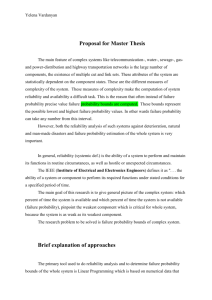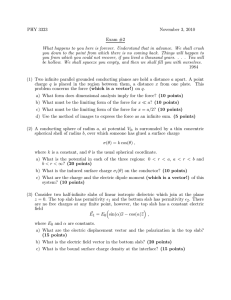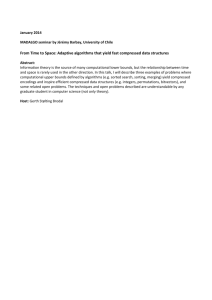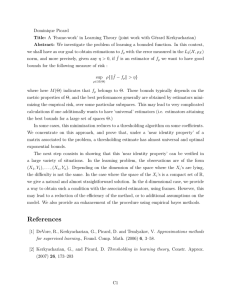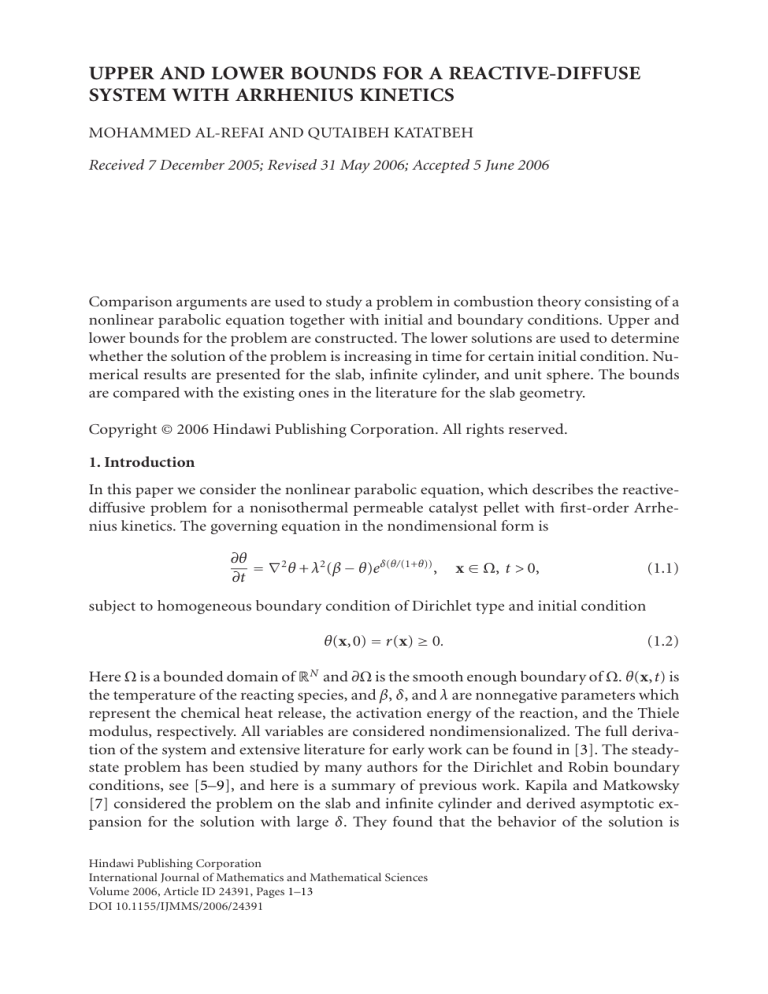
UPPER AND LOWER BOUNDS FOR A REACTIVE-DIFFUSE
SYSTEM WITH ARRHENIUS KINETICS
MOHAMMED AL-REFAI AND QUTAIBEH KATATBEH
Received 7 December 2005; Revised 31 May 2006; Accepted 5 June 2006
Comparison arguments are used to study a problem in combustion theory consisting of a
nonlinear parabolic equation together with initial and boundary conditions. Upper and
lower bounds for the problem are constructed. The lower solutions are used to determine
whether the solution of the problem is increasing in time for certain initial condition. Numerical results are presented for the slab, infinite cylinder, and unit sphere. The bounds
are compared with the existing ones in the literature for the slab geometry.
Copyright © 2006 Hindawi Publishing Corporation. All rights reserved.
1. Introduction
In this paper we consider the nonlinear parabolic equation, which describes the reactivediffusive problem for a nonisothermal permeable catalyst pellet with first-order Arrhenius kinetics. The governing equation in the nondimensional form is
∂θ
= ∇2 θ + λ2 (β − θ)eδ(θ/(1+θ)) ,
∂t
x ∈ Ω, t > 0,
(1.1)
subject to homogeneous boundary condition of Dirichlet type and initial condition
θ(x,0) = r(x) ≥ 0.
(1.2)
Here Ω is a bounded domain of RN and ∂Ω is the smooth enough boundary of Ω. θ(x,t) is
the temperature of the reacting species, and β, δ, and λ are nonnegative parameters which
represent the chemical heat release, the activation energy of the reaction, and the Thiele
modulus, respectively. All variables are considered nondimensionalized. The full derivation of the system and extensive literature for early work can be found in [3]. The steadystate problem has been studied by many authors for the Dirichlet and Robin boundary
conditions, see [5–9], and here is a summary of previous work. Kapila and Matkowsky
[7] considered the problem on the slab and infinite cylinder and derived asymptotic expansion for the solution with large δ. They found that the behavior of the solution is
Hindawi Publishing Corporation
International Journal of Mathematics and Mathematical Sciences
Volume 2006, Article ID 24391, Pages 1–13
DOI 10.1155/IJMMS/2006/24391
2
Bounds for a reactive-diffuse system
similar for both geometries and therefore only presented the results for the infinite cylinder. For the slab geometry the steady-state system has been reduced to a single equation
by integrating the governing differential equation twice, see [5]. The literature shows that
for certain values of δ and β there exist λo and λo such that the steady-state system has
multiple solutions for λo ≤ λ ≤ λo . Here λo and λo correspond to extinction and ignition
limits, respectively, and the corresponding steady-state solutions are known as the middle
solutions, whereas for λ > λo and λ < λo the unique steady-state solutions are known as
the upper and lower solutions, respectively. The number of middle solutions depends on
the geometry of the domain Ω and the boundary conditions [6–8]. Of interest are the
values of λo and λo . An attempt to evaluate these values was made in [7] for the slab and
infinite cylinder geometries using asymptotic expansion approach. Recently, Al-Refai [1]
has considered the problem with Dirichlet boundary conditions. He proved the existence
of a nonnegative solution and derived sharp upper and lower bounds for the values of λ
and δ using comparison theory. Also in [2] he derived analytical upperand lower bounds
for the extinction and ignition limits for the three geometries: slab, infinite cylinder, and
unit sphere. Although the steady-state problem may have more than one solution, the
problem with time-dependent has a unique solution provided that 0 ≤ θ(x,0) ≤ β (see
[10, page 42]).
In this paper, we study the time-dependent problem in the slab [0,1], in the unit
sphere, and infinite cylinder. In Section 2, we write some preliminary results for the system which will be used through the text. In Section 3, we construct upper and lower
solutions for the problem (1.1)-(1.2). In Section 4, we present some numerical results in
the three geometries. Finally, we write some concluding remarks in Section 5.
2. A preliminary result
We have the problem
Pθ =
∂θ
− ∇2 θ − λ2 g(θ) = 0,
∂t
θ(x,t) = 0,
x ∈ Ω, t > 0,
x ∈ ∂Ω,
(2.1)
θ(x,0) = r(x) ≥ 0,
where g(θ) = (β − θ)eδ(θ/(1+θ)) . A well known result for the system is that 0 ≤ θ(x,t) ≤ β
provided that r(x) ≤ β. If δβ ≤ 1, then
g (θ) = −
eδ(θ/(θ+1)) 2
θ + (2 + δ)θ + 1 − δβ < 0,
2
(θ + 1)
(2.2)
and the corresponding steady-state problem has a unique solution, see [2, 10]. While, for
δ > 4 + 4/β, the steady-state problem may have more than one solution. The following
result will be used in this paper.
M. Al-Refai and Q. Katatbeh 3
Proposition 2.1. Consider the problem in (2.1) with g (θ) being bounded.
(i) If (∂θ/∂t)(x,0) < 0, then (∂θ/∂t)(x,t) < 0 for all x ∈ Ω, and t ≥ 0.
(ii) If (∂θ/∂t)(x,0) > 0, then (∂θ/∂t)(x,t) > 0 for all x ∈ Ω, and t ≥ 0.
For the proof one can see [4, 12].
3. Upper and lower bounds
To construct upper and lower bounds for the problem we use maximum principle for
parabolic equations, see [11, page 187]. Let w(x,t) and u(x,t) satisfy
Pw ≤ 0 ≤ Pu,
x ∈ Ω, t > 0,
w(x,t) ≤ 0 ≤ u(x,t),
x ∈ ∂Ω,
(3.1)
w(x,0) ≤ r(x) ≤ u(x,0).
Then w(x,t) and u(x,t) are lower and upper solutions for the problem in (2.1), respectively, w(x,t) ≤ θ(x,t) ≤ u(x,t), as long as both exist.
Let λ1 be the first eigenvalue and φ1 the corresponding normalized, with respect to
L2 -norm, eigenfunction of
∇2 φ = −λφ,
x ∈ Ω,
x ∈ ∂Ω.
φ = 0,
√
(3.2)
√
It is easily obtained that φ1 = 2sin(πx), (1/ 2π)(sin(πx)/x), and J0 (γ0 x), for the slab,
spherical, and cylindrical geometries, respectively. Here J0 (γ0 x) is the Bessel function of
order zero, γ0 = 2.404825 ... is the first zero of J0 (x), and 0 ≤ x ≤ 1. In all cases, the first
eigenfunction φ1 is nonnegative in Ω.
3.1. Bounds when g(θ) is decreasing. We derive upper and lower solutions for the problem when δβ ≤ 1 and so g(θ) is decreasing. The function g(θ) has only one inflection
point θ 0 = (δβ − 2β − 2)/(δ + 2 + 2β), and g(θ) is concave up for θ < θ 0 and concave down
for θ > θ 0 . For δβ ≤ 1, we have θ 0 < 0, and therefore, g(θ) is concave down on [0,β].
Theorem 3.1. Let φ1 and λ1 be as defined in (3.2) and let φ1m be the maximum of φ1 on Ω.
Let k(t) be the solution of the IVP
k (t) = λ2 g k(t) − λ1 k(t),
k(0) = k0 .
(3.3)
Then k0 ≤ k(t) ≤ km and w(x,t) = k(t)(φ1 (x)/φ1m ) is a lower solution of (2.1). Here km is
the unique solution of g(km ) = (λ1 /λ2 )km and k0 = k(0) is chosen such that k0 (φ1 (x)/φ1m ) ≤
r(x).
Proof. Since g(0) = β > 0, we have (λ1 /λ2 )u ≤ g(u) for 0 ≤ u ≤ km and (λ1 /λ2 )u ≥ g(u)
for km ≤ u ≤ β. If k0 < km , then k (t) ≥ 0 and k(t) is increasing with equilibrium value km ,
4
Bounds for a reactive-diffuse system
and therefore, k0 ≤ k(t) ≤ km . The analogous result is obtained if km ≤ k0 ≤ β, but k(t) is
decreasing. Now,
Pw = k
φ1
φ1
φ1
+ λ1 k
− λ2 g k
φ1m
φ1m
φ1m
φ1 2
φ1
φ1
λ g(k) − λ2 g k
≤ λ2 g(k) − g k
=
φ1m
φ1m
φ1m
(3.4)
.
Since k(t)(φ1 /φ1m ) ≤ k(t) and g is decreasing, we have Pw ≤ 0, which together with
w(x,0) ≤ r(x) proves that w is a lower solution of (2.1).
Theorem 3.2. Let ψ be the solution of
∇2 ψ = −1,
x ∈ Ω,
(3.5)
x ∈ ∂Ω.
ψ = 0,
Then ψ ≥ 0, and u(x,t) = h(t)ψ(x) is an upper solution of (2.1), where
h(t) = h0 −
1
λ2 g (0)
1 − eλ g (0)t ,
2 (3.6)
and h0 = h(0) is chosen such that h0 ≥ λ2 β and h0 ψ(x) ≥ r(x).
Proof. To show that ψ ≥ 0, let ξ = −ψ, then ξ satisfies ∇2 ξ = 1 ≥ 0, and ξ = 0 on ∂Ω.
Using maximum principle of elliptic equations (see [11, page 64]), we have ξ ≤ 0, and
hence ψ ≥ 0. Since g (0) = δβ − 1 ≤ 0, it is not difficult to see that h(t) is increasing with
h0 ≤ h(t) ≤ h0 +
1
,
λ2 (1 − δβ)
(3.7)
and it is the unique solution of the IVP
h − λ2 g (0)h = 0,
h(0) = h0 > 0,
h (0) = 1.
(3.8)
Now, Pu = h ψ + h − λ2 g(hψ) and
∂Pu
= h ψ + h − λ2 h ψg (hψ) = h − λ2 h g (hψ) ψ + h .
∂t
(3.9)
Since h(t)ψ ≥ 0 and g is decreasing, we have
∂Pu ≥ h − λ2 h g (0) ψ + h (t) = h (t).
∂t
(3.10)
Integrate the above inequality from 0 to t to get
Pu − Pu(0) ≥ h(t) − h(0),
(3.11)
M. Al-Refai and Q. Katatbeh 5
or
Pu ≥ ψ + h(t) − λ2 g h0 ψ ≥ h(t) − λ2 β ≥ 0,
(3.12)
which together with u(x,0) = h0 ψ(x) ≥ r(x) ≥ 0 proves that u is an upper solution of
(2.1).
3.2. Lower solutions for δ > 4 + 4/β. When δ > 4 + 4/β, the inflection point θ 0 =
(β(δ − 2) − 2)/(δ + 2 + 2β) ∈ [0,β]. Let θ ∗ ∈ [0,β] be the smallest solution of (λ1 /λ2 )θ =
g(θ) and λ1 /λ2 = g (θ), and let λ∗ be the corresponding value of λ, see Figure 3.1. For the
exact values of θ ∗ and λ∗ , one is referred to [2]. We have the following.
Proposition 3.3. (1) θ 0 = (β(δ − 2) − 2)/(δ+2β+2) > θ ∗ = (β(δ − 2) − βδ(βδ − 4β − 4))/
2(β + δ) for δ > 4 + 4/β.
(2) The function h(θ) = g(θ) − (λ1 /λ2 )θ is decreasing in [0,θ ∗ ] for λ ≤ λ∗ .
Proof. (1) It is enough to show that
β(δ − 2) − 2 β(δ − 2)
>
,
δ + 2 + 2β
2(β + δ)
(3.13)
or
2(β + δ) β(δ − 2) − 2 > β(δ − 2)(δ + 2β + 2).
(3.14)
The last inequality is equivalent to
βδ 2 − δ(4β + 4) ≥ 0.
(3.15)
Now, 4β + 4 < βδ and hence −δ(4β + 4) > −βδ 2 , which proves (3.15).
(2) Since θ ∗ < θ 0 , we have g (θ) increasing in [0,θ ∗ ] and hence h (θ) = g (θ) − λ1 /λ2 ≤
∗
g (θ ) − λ1 /(λ∗ )2 = 0, which proves the result.
Theorem 3.4. Let φ1 and λ1 be as defined in (3.2) and let φ1m be the maximum of φ1 on Ω.
For λ ≤ λ∗ , let k(t) be the solution of the IVP
k (t) =
1
λ2 g k(t)φ1m − λ1 k(t)φ1m ,
φ1m
k(0) = k0 ,
(3.16)
where k0 ≤ kM is chosen such that k0 φ1 (x) ≤ r(x), and kM is the solution (the smallest solution if there is more than one) of λ2 g(kM φ1m ) = λ1 kM φ1m , see Figure 3.1. Then k(t) is
an increasing function, with k0 ≤ k(t) ≤ kM , and w(x,t) = k(t)φ1 (x) is a lower solution of
(2.1).
6
Bounds for a reactive-diffuse system
9
8
g(θ)
7
6
5
λ1 /λ2 θ
4
3
2
1
0
λ1 /(λ )2 θ
kM φ1m
0
θ
0.05
0.1
0.15
0.2
0.25
0.3
Figure 3.1. The values of θ ∗ and kM , for β = 0.3 and δ = 25.
Proof. Since k0 ≤ kM and (λ1 /λ2 )φ1m u ≤ g(φ1m u) for 0 ≤ u ≤ kM , we have k(t) increasing
with equilibrium value kM , that is, k0 ≤ k(t) ≤ kM . Now,
Pw = k (t)φ1 + λ1 k(t)φ1 − λ2 g k(t)φ1
φ1 2 λ g kφ1m − λ1 kφ1m + λ1 kφ1 − λ2 g kφ1
=
φ1m
2 ≤ λ g kφ1m − λ1 kφ1m − λ2 g kφ1 − λ1 kφ1 .
(3.17)
Since g(θ) − (λ1 /λ2 )θ is decreasing in [0,θ ∗ ] for λ ≤ λ∗ , we have Pw ≤ 0 and the result
is obtained.
Theorem 3.5. For λ > λ∗ , let (λ) > 1 be such that g(θ ∗ ) = (λ1 /λ2 )θ ∗ , and let k(t) be the
solution of
k (t) =
1
λ2 g k(t)φ1m − λ1 k(t)φ1m ,
φ1m
k(0) = k0 ,
(3.18)
where k0 ≤ θ ∗ /φ1m is chosen such that k0 φ1 (x) ≤ r(x). Then the function h(θ) = g(θ) −
(λ1 /λ2 )θ is decreasing in [0,θ ∗ ] and w(x,t) = k(t)φ1 (x) is a lower solution of (2.1).
Proof. Since = (λ/λ∗ )2 , we have h(θ) = g(θ) − (λ1 /(λ∗ )2 )θ and h (θ) = g (θ) − λ1 /(λ∗ )2 ≤
g (θ ∗ ) − λ1 /(λ∗ )2 = 0. Using the same arguments as in the previous theorem, one can
verify that k(t) is increasing in k0 ≤ k(t) ≤ θ ∗ /φ1m . Since g(θ) − (λ1 /λ2 )θ is decreasing
M. Al-Refai and Q. Katatbeh 7
in [0,θ ∗ ] and > 1 we have
Pw = k (t)φ1 + λ1 k(t)φ1 − λ2 g k(t)φ1
=
φ1 2 λ g kφ1m − λ1 kφ1m − λ2 g kφ1 − λ1 kφ1
φ1m
≤ λ2 g kφ1m − λ1 kφ1m − λ2 g kφ1 − λ1 kφ1
λ1
λ1
2
g kφ1m − 2 kφ1m − g kφ1 − 2 kφ1 ≤ 0,
=λ
λ
(3.19)
λ
which proves the result.
4. Numerical results
We consider the case where g(θ) is decreasing, and use Theorems 3.1 and 3.2 to obtain lower and upper solutions of (2.1). We present the bounds for different values of
λ, β, δ and 0 ≤ t ≤ 0.2, with initial condition θ(x,0) = λ2 βψ(x), where ψ(x) is defined
in Theorem 3.2. Figures 4.1, 4.2, and 4.3 depict these bounds of the problem when Ω
is the slab, unit sphere, and infinite cylinder, respectively, and β = 0.5, δ = 0.1, and λ =
0.5,1,2,5. In order for the condition k0 (φ1 /φ1m ) ≤ r(x) to be satisfied in Theorem 3.1, we
take k0 = λ2 β/8, λ2 β/18.9, λ2 β/6.4, for the slab, sphere, and infinite cylinder, respectively.
From the figures one can see that the upper bounds are increasing in time, where
h(t) = λ2 β +
1 1 2
1 − e−λ (1−δβ)t ,
2
λ 1 − δβ
(4.1)
whereas the lower bounds are decreasing or increasing in time, depending on the geometry k0 and km . For example, the lower solutions are decreasing in time in the slab geometry
since k0 > km , while they are increasing with time for λ = 0.5,1,2 and decreasing for λ = 5
in the sphere. Table 4.1 shows k0 and km , for β = 0.5, δ = 0.1, and different values of λ.
Also, the upper and lower solutions are close to each other and give good information
about the exact solution θ.
From Proposition 2.1 we have that if θt (x,0) = 0, then the solution θ is either increasing or decreasing in time. We now take θ(x,0) = cφ1 (x) and ask the following: for what
values of c the solution θ of (2.1) is increasing with respect to time? To answer the question, we substitute k0 = cφ1m in Theorem 3.1. Since θ(x,0) = w(x,0) and w(x,t) is increasing in time for c < km /φ1m , then so is θ.
Finally, we compare our bounds with the bounds obtained in [10]. Consider the PDE
∂v
= ∇2 v − λ2 c0 v + μ0 β, x ∈ Ω,
∂t
v(x,t) = 0, x ∈ ∂Ω,
(4.2)
v(x,0) = r(x) ≥ 0,
where c0 = max{−λ2 g (v), 0 ≤ v ≤ β}. Let v(x,t) be the solution of (4.2) with μ0 = c0 ,
then v(x,t) is an upper solution of (2.1). A lower solution v(x,t) of (2.1) is obtained
by solving (4.2) with μ0 = λ2 . For more details one can see [10, page 36]. For the slab
8
Bounds for a reactive-diffuse system
λ = 0.5
0.05
0.04
0.03
0.02
0.01
0
100
λ=1
0.1
0.05
x
50
20
0 40
0
0
100
x
t
50
(a)
x
50
0 40
0
t
(b)
λ=2
0.4
0.3
0.2
0.1
0
100
20
λ=5
10 0
0 30 20 t
2
1.5
1
0.5
0
100
x
20
50
(c)
0 40
0
t
(d)
Figure 4.1. Upper and lower bounds for the slab geometry, when β = 0.5, δ = 0.1, and λ = 0.5,1,2,5.
λ = 0.5
λ=1
0.2
0.06
0.04
0.02
0
40
0.1
t
20
0 0
50
100
0
40
x
t
20
(a)
0.2
20
0 0
(c)
100
x
λ=5
0.4
t
50
(b)
λ=2
0
40
0 0
50
100
x
3
2
1
0
40
t
20
0 0
50
100
x
(d)
Figure 4.2. Upper and lower bounds for the spherical geometry, when β = 0.5, δ = 0.1, and λ =
0.5,1,2,5.
M. Al-Refai and Q. Katatbeh 9
λ = 0.5
λ=1
0.2
0.4
0.1
0.2
0
50
t
0 0
50
100
0
50
t
x
(a)
λ=5
1
4
0.5
2
0
50
0 0
100
x
(b)
λ=2
t
50
0 0
50
100
x
0
50
t
(c)
0 0
50
100
x
(d)
Figure 4.3. Upper and lower bounds for the cylindrical geometry, when β = 0.5, δ = 0.1, and λ =
0.5,1,2,5.
Table 4.1. The values of k0 and km , for β = 0.5 and δ = 0.1, in the three geometries.
Slab
Sphere
Cylinder
λ
0.5
1.0
2.0
5.0
k0
km
k0
km
k0
km
0.015625
0.012367
0.006614
0.012367
0.019531
0.020759
0.062500
0.046185
0.026455
0.046185
0.078125
0.074147
0.250000
0.145507
0.105820
0.145507
0.312500
0.206504
1.562500
0.361155
0.661380
0.361155
1.953100
0.408257
geometry we have
2β ∞ 1 − (−1)n λ2 −rn t μ0 v(x,t) =
e
+
1 − e−rn t sin(nπx),
π n =1
n
n2 π 2
rn
v(x,t) =
2βλ2 ∞ 1 − (−1)n
1 −r n t 1 e
+
1 − e−rn t sin(nπx),
π n =1
n
n2 π 2
rn
(4.3)
where rn = n2 π 2 + λ2 μ0 and μ0 = 1.033895.
Figures 4.4 and 4.5 on the left show the upper solutions u and v and on the right
the difference between them. For λ = 0.1 and 0.5 we have v − u ≥ 0, that is, the upper
10
Bounds for a reactive-diffuse system
λ = 0.1
λ = 0.1
0.06
0.04
0.02
0
0
10
20 40
x
20
t
0
0.04
0.03
0.02
0.01
0
0.01
0 10 20 40
x
(a)
0
t
(b)
λ = 0.5
λ = 0.5
0.02
0.01
0.06
0.04
0.02
0
0
20
10
20 40
x
20
t
0
0
0.01
0
x
10
0
20 30 20 10
t
(c)
(d)
Figure 4.4. The upper solutions u(x,t) and v(x,t) and the difference v(x,t) − u(x,t) for the slab geometry, when β = 0.5, δ = 0.1, and λ = 0.1,0.5.
λ=1
λ=1
0.02
0.1
0
0.05
0.02
0
0
t
20
40 0
10
20
0.04
0
t
x
20
(a)
40 0
10 20
x
(b)
λ=4
λ=4
1.5
1
1
0.5
0
0
0
20
t
40 0
(c)
1
10
20
x
20
0
10
20
t
40 0
x
(d)
Figure 4.5. The upper solutions u(x,t) and v(x,t) and the difference v(x,t) − u(x,t) for the slab geometry, when β = 0.5, δ = 0.1, and λ = 1,4.
M. Al-Refai and Q. Katatbeh 11
10
10
λ = 0.1
4
8
6
4
2
0
15 10
5 0
x
10
t
20 30
λ = 0.1
4
1.5
1
0.5
0
20
10
0
x
(a)
5 10 15 20 25
t
(b)
λ = 0.5
10
3
0.02
0.01
0
15 10
30
5 0 0 10 20
x
t
3
2
1
0
15 10
30
5 0 0 10 20
x
t
(c)
(d)
Figure 4.6. The lower solutions w(x,t) and v(x,t) and the difference v(x,t) − w(x,t) for the slab geometry, when β = 0.5, δ = 0.1, and λ = 0.1,0.5.
λ=1
λ=1
0.1
0.01
0.05
0.005
0
20
x
10
0 0
20
40
0
20
x
t
10
(a)
0.1
1
0.05
10
0 0
(c)
40
t
λ=4
2
x
20
(b)
λ=4
0
20
0 0
20
40
t
0
20
x
10
0 0
20
40
t
(d)
Figure 4.7. The lower solutions w(x,t) and v(x,t) and the difference v(x,t) − w(x,t) for the slab geometry, when β = 0.5, δ = 0.1, and λ = 1,4.
solution u is better than v. Whereas for λ = 1 and 4 we have u ≥ v, and the upper solution
v is better than u. Figures 4.6 and 4.7 on the left show the lower solutions w and v and on
12
Bounds for a reactive-diffuse system
the right the difference between them. One can see that the two bounds are close to each
other and for all values of λ we have v ≥ w, that is, the lower solution v is better than w.
5. Concluding remarks
We have used comparison arguments to study a nonlinear parabolic equation arising
from the theory of catalyst pellets reaction. For δβ ≤ 1, a lower solution of the form
w(x,t) = k(t)(φ1 /φ1m ) is obtained, where φ1 is the first normalized eigenfunction of the
associated Laplacian operator, φ1m is the maximum of φ1 in Ω, and k(t) is the solution
of an IVP. Depending on the initial condition k(0), the function k(t) might be decreasing
or increasing. An upper solution of the form u(x,t) = h(t)ψ(x) is obtained by solving a
second-order linear IVP for h(t) and a linear PDE for ψ, where h(t) is increasing in time.
The lower solution is used to give a sufficient condition for the solution θ to be increasing
in time for certain initial condition. For the case where δ > 4 + 4/β, we have constructed
a lower solution w(x,t) = k(t)φ1 (x), where k(t) is increasing and depends on the value of
λ∗ . We present the upper and lower solutions for certain parameters in the three geometries numerically. These upper and lower solutions are compared with the ones obtained
by Pao [10] for the slab geometry.
References
[1] M. Al-Refai, Existence, uniqueness and bounds for a problem in combustion theory, Journal of
Computational and Applied Mathematics 167 (2004), no. 2, 255–269.
, Bounds and critical parameters for a combustion problem, Journal of Computational and
[2]
Applied Mathematics 188 (2006), no. 1, 33–43.
[3] R. Aris, The Mathematical Theory of Diffusion and Reaction in Permeable Catalysts, Vol. I, Clarendon Press, Oxford, 1975.
[4] J. Bebernes and D. Eberly, Mathematical Problems from Combustion Theory, Applied Mathematical Sciences, vol. 83, Springer, New York, 1989.
[5] D. W. Drott and R. Aris, Communications on the theory of diffusion and reaction—I: a complete
parametric study of the first-order, irreversible exothermic reaction in a flat slap of catalyst, Chemical Engineering Science 24 (1969), no. 3, 541–551.
[6] A. K. Kapila and B. J. Matkowsky, Reactive-diffuse systems with Arrhenius kinetics: multiple solutions, ignition and extinction, SIAM Journal on Applied Mathematics 36 (1979), no. 2, 373–389.
, Reactive-diffusive system with Arrhenius kinetics: the Robin problem, SIAM Journal on
[7]
Applied Mathematics 39 (1980), no. 3, 391–401.
[8] A. K. Kapila, B. J. Matkowsky, and J. Vega, Reactive-diffusive system with Arrhenius kinetics: peculiarities of the spherical geometry, SIAM Journal on Applied Mathematics 38 (1980), no. 3,
382–401.
[9] M. L. Michelsen and J. Villadsen, Diffusion and reaction on spherical catalyst pellets: steady state
and local stability analysis, Chemical Engineering Science 27 (1972), no. 4, 751–762.
[10] C. V. Pao, Nonlinear Parabolic and Elliptic Equations, Plenum Press, New York, 1992.
[11] M. H. Protter and H. F. Weinberger, Maximum Principles in Differential Equations, Springer,
New York, 1984.
M. Al-Refai and Q. Katatbeh 13
[12] D. H. Sattinger, Monotone methods in nonlinear elliptic and parabolic boundary value problems,
Indiana University Mathematics Journal 21 (1972), no. 11, 979–1000.
Mohammed Al-Refai: Department of Mathematics and Statistics, Jordan University of Science and
Technology, P.O. Box 3030, Irbid 22110, Jordan
E-mail address: m alrefai@yahoo.com
Qutaibeh Katatbeh: Department of Mathematics and Statistics, Jordan University of Science and
Technology, P.O. Box 3030, Irbid 22110, Jordan
E-mail address: qutaibeh@yahoo.com

